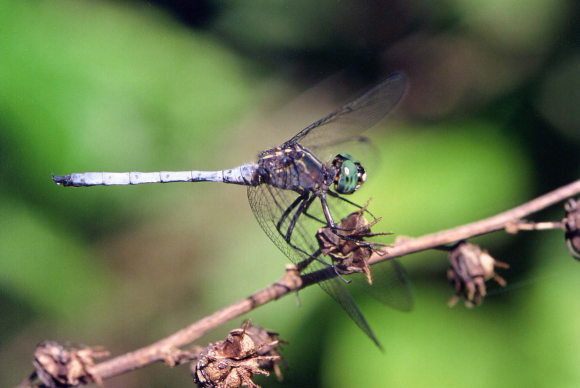Genus Atoconeura Karsch, 1899
highlanders
Synonyms:
- scientific: Accaphila Kirby, 1909 [eudoxia]
Type species: Atoconeura biordinata Karsch, 1900
Introduction
Endemic to tropical Africa with six species. The genus occurs in streams, mainly above 1000 m and often in forest, and can be dominant in montane habitats. Three species were formerly regarded as subspecies of A. biordinata: although largely excluding each other, they meet locally, e.g. A. biordinata and A. kenya on Kilimanjaro, A. eudoxia and A. pseudeudoxia in south-western Uganda, and A. biordinata and A. pseudeudoxia in Katanga and northern Zambia. Ecological differences are poorly known, but A. eudoxia and A. pseudeudoxia prefer sluggish and rapid streams respectively, while A. kenya ventures comparatively higher, to 3000 m. All are medium-sized (hindwing 28-38 mm) and easily recognised by their black bodies with bold yellow markings, most notably the ‘signal’ spot on the somewhat clubbed abdomen tip. However, two species attain a pruinose abdomen, obscuring this mark, of which the barely clubbed A. aethiopica in particular recalls an Orthetrum. A. luxata occurs below 1000 m in western Africa. It has also been reported from Katanga, although this must represent mislabelling. [Adapted from Dijkstra & Clausnitzer 2014]
Diagnosis
Genus not particularly close to any other Libellulids, but similar to some by (a) distal Ax in Fw complete, extends across subcosta like proximal Ax; (b) 2-4 Cux in Hw; (c) always 1 cell-row in radial planate; (d) hindlobe large, roundly rectangular or bilobed and constricted at base (dorsal view), flat or even raised (lateral view), its border with dense fringe of long hairs that are often even longer than lobe itself; (e) S7 with conspicuous pale mark, which is more prominent than any marking on S6 (invisible when covered by pruinosity). However, Atoconeura is set apart from the rest by (1) size, Hw 28-38 mm; (2) Fw discoidal field of 2-3 rows at base; (3) Fw triangle of 2, subtriangle of 3 cells [2-3]; (4) Fw supratriangle without cross-vein; (5) hamule with large apical hook. [Adapted from Dijkstra & Clausnitzer 2014; this diagnosis not yet verified by author]

Atoconeura aethiopica Kimmins, 1958. © Viola Clausnitzer

Atoconeura eudoxia (Kirby, 1909). © KD Dijkstra
Map citation: Clausnitzer, V., K.-D.B. Dijkstra, R. Koch, J.-P. Boudot, W.R.T. Darwall, J. Kipping, B. Samraoui, M.J. Samways, J.P. Simaika & F. Suhling, 2012. Focus on African Freshwaters: hotspots of dragonfly diversity and conservation concern. Frontiers in Ecology and the Environment 10: 129-134.
References
- Longfield, C. (1953). The Atoconeura problem (Odon., Libellulidae). Entomologist, 86, 42-49. [PDF file]
- Dijkstra, K.-D.B. (2006). The Atoconeura problem revisited: taxonomy, phylogeny and biogeography of a dragonfly genus in the highlands of Africa (Odonata, Libellulidae). Tijdschrift voor Entomologie, 149, 121-144. [PDF file]
- Dijkstra, K.-D.B, and Clausnitzer, V. (2014). The Dragonflies and Damselflies of Eastern Africa: handbook for all Odonata from Sudan to Zimbabwe. Studies in Afrotropical Zoology, 298, 1-264.
- Karsch, F. (1899). Neue Odonaten aus Ost- und Süd-Afrika mit Einschluss des Seengebietes. Entomologische Nachrichten, 25, 369-382. [PDF file]
- Pinhey, E.C.G. (1961). Dragonflies (Odonata) of Central Africa. Occasional Papers Rhodes-Livingstone Museum, 14, 1-97. [PDF file]
- Schouteden, H. (1934). Annales Musee Congo belge Zoologie 3 Section 2, 3, 1-84. [PDF file]
Citation: Dijkstra, K.-D.B (editor). African Dragonflies and Damselflies Online. http://addo.adu.org.za/ [2024-10-30].

